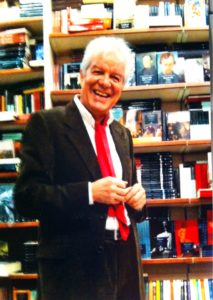Logical and Factual truths
 “The father of science, Democritus, when the Greeks asked him to show them what an atom was, he took a piece of cheese, put it on a table, took a knife and then in front of them started cutting the cheese into two pieces. He went on cutting each piece into two pieces until he couldn’t cut the last piece anymore. Then Democritus stopped cutting, looked at the people who were watching him carefully and said: ‘Here is your atom, the piece that I no longer can divide into two pieces’. This is not theory, this is science. Science can exist without theory, but not theory without science”.
“The father of science, Democritus, when the Greeks asked him to show them what an atom was, he took a piece of cheese, put it on a table, took a knife and then in front of them started cutting the cheese into two pieces. He went on cutting each piece into two pieces until he couldn’t cut the last piece anymore. Then Democritus stopped cutting, looked at the people who were watching him carefully and said: ‘Here is your atom, the piece that I no longer can divide into two pieces’. This is not theory, this is science. Science can exist without theory, but not theory without science”.
Bart Kosko*, in his book “The Fuzzy-Thought”, defines logical truths and factual truths as follows: “The difference between logical truth and factual truth founds two vast theories, the theory of coherence and the theory of correspondence. Logical truth is part of the theory of coherence or truth as coherence. The statement 1 + 1 = 2 is true because we have consistently applied the rules of mathematics. The fairy tale ‘the little mermaid’is true in the sense that it is coherent, that is internally consistent, but doesn’t correspond to any real fact.” In fact, in nature, ‘the little mermaid’doesn’t exist.
We could say the same thing for those who talk about wormholes, dark matter, dark energy, parallel universes, one and eleven dimensional universes, quantum mechanics, general relativity, black holes and white holes, strings in 6 dimensions, space-time, journeys to the borders of the big bang and of crumpled universes, and so on. All these words have meaning only and only if they are applied coherently, that is with the abstract theories they have elaborated and to which they depend. Outside of these theories, they have no identity, they cease to be consistent, therefore to be useful.
Bart Kosko continues: “Mathematics itself is neither true nor false. We accept or reject mathematics for practical reasons. The statements within a system are different from those outside of a system. The statement “the numbers exist” is true within the mathematical system, but has little meaning outside of it”.
The same is true for time, space, nature, the unicorn, the centaur, geometry, music and other inventions that have their own internal coherence. Has anyone seen “time” as a fish swimming in the water? Has anyone touched “nature” with his hands as he touches a piece of ice? Has anyone seen a “centaur” as he saw an elephant?
The factual truths, on the other hand, apply to statements that describe real facts or events: today rained, man is mortal, the river is in flood, that woman is pregnant.
Factual truths, those that correspond to real phenomena, have to do with the world of phenomena, of substance, of physical objects; the formal truths, truths that in order to be truths must be coherent in themselves, instead, are not interested as the world is made or not made, are only interested to find an internal coherence among them – mathematics, fiction novels, “the Lord of the Rings”, etc. Their goal is to show that things work within their discourse, system, science, fabrication, philosophy. I call them in the Italian language “vuotaggine ragionata – reasoned emptyness” that is everything that has nothing to do with true and raw reality.
The current string theory, which is nothing but an orgasm of numbers, confirms what we are saying. String theory, in fact, is nothing else, but only a mountain of numbers and equations all coherent among themselves and with each other. This way of reasoning has nothing to do with the world of factual truths. Therefore, there are false statements and true statements. The first belong to inventions; the latter to phenomenal reality. We must be able to distinguish between the two.
In the early 1970s, in Melbourne, Australia, I dared to write quartets in English. I was amazed to discover that, despite my little knowledge of the English language, I always found the word that rhyme at the end of my quartet and no matter how difficult it was. It seemed to me that maths and quartets were very similar. Today I am convinced that with theories one will always manage to create whatever he imagines or desires. It is a question, not of facts, but of inventive coherence.
*Bart Kosko “Fuzzy Thinking: The New Science of Fuzzy logics, 1993”.
